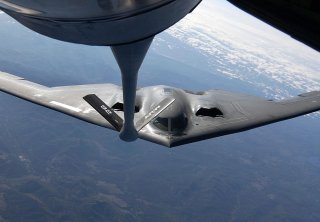Why America's B61 Nuclear Bomb Lives On
It is being upgraded under a life extension program.
The Air Force is working with Boeing to sustain and improve an advanced variant of the B61 air-dropped nuclear bomb, engineered to give pilots much-expanded attack options with which to hold potential adversaries at risk from the air. The Air Force just awarded Boeing a continued development deal for the weapon.
In recent years, The Air Force has been test-dropping the upgraded, multi-function B61-12 nuclear bomb which improves accuracy, integrates various attack options into a single bomb and changes the strategic landscape with regard to nuclear weapons mission possibilities.
The B61-12 adds substantial new levels of precision targeting and consolidates several different kinds of attack options into a single weapon. Instead of needing separate variants of the weapon for different functions, the B61-12 by itself allows for earth-penetrating attacks, low-yield strikes, high-yield attacks, above surface detonation and bunker-buster options.
The latest version of the B61 thermonuclear gravity bomb, which has origins as far back as the 1960s, is engineered as a low-to-medium yield strategic and tactical nuclear weapon, according to nuclearweaponsarchive.org, which also states the weapon has a “two-stage” radiation implosion design.
Air Force officials describe this, in part, by referring to the upgraded B61-12 as having an “All Up Round.”
The B61 Mod 12 is engineered with a special “Tail Subassembly” to give the bomb increased accuracy, giving a new level of precision targeting using Inertial Navigation Systems, according to information from the Nuclear Information Project, Federation of American Scientists.
Right now, the B-2 carries only B61-7 (10-360 kt), B61-11(400 kt, earth-penetrator), and B83-1 (high-yield bunker-buster). The B61-12 covers all of those missions. The evidence that the B61-12 can penetrate below the surface has significant implications for the types of targets that can be held at risk with the bomb.
By bringing an “earth-penetrating” component, the B61-12 vastly increases the target scope or envelope of attack. It can enable more narrowly targeted or pinpointed strikes at high-value targets underground—without causing anywhere near the same level of devastation above ground or across a wider area.
The testing and integration of the B61-12 is one piece of a massive, fleet-wide B-2 upgrade designed to sustain the bomber into coming years, until large numbers of the emerging B-21 Raider are available. A range of technical modifications are also intended to prepare the 1980s-era bomber for very sophisticated, high-end modern threats.
The B-2 is getting improved digital weapons integration, new computer processing power reported to be 1,000-times faster than existing systems and next-generation sensors designed to help the aircraft avoid enemy air defenses. One of the effort’s key modifications is designed to improve what’s called the bomber’s Defensive Management System, a technology designed to help the B-2 recognize and elude enemy air defenses, using various antennas, receivers and display processors.
The Air Force is also integrating the B61 Mod 12 nuclear weapon into the F-35A this year as part of a long-range plan to deploy a nuclear-armed, dual-capable F-35 able to give commanders a wider envelope of precision nuclear attack options.
The Block 4 F-35 will fully emerge in the next decade and contains more than 50 technical adjustments to the aircraft designed as software and hardware builds. These will be added in six-month increments between April 2019 to October 2024, Air Force officials explained.
Kris Osborn is the defense editor for the National Interest. Osborn previously served at the Pentagon as a Highly Qualified Expert with the Office of the Assistant Secretary of the Army—Acquisition, Logistics & Technology. Osborn has also worked as an anchor and on-air military specialist at national TV networks. He has appeared as a guest military expert on Fox News, MSNBC, The Military Channel, and The History Channel. He also has a Masters Degree in Comparative Literature from Columbia University.
Image: Reuters

